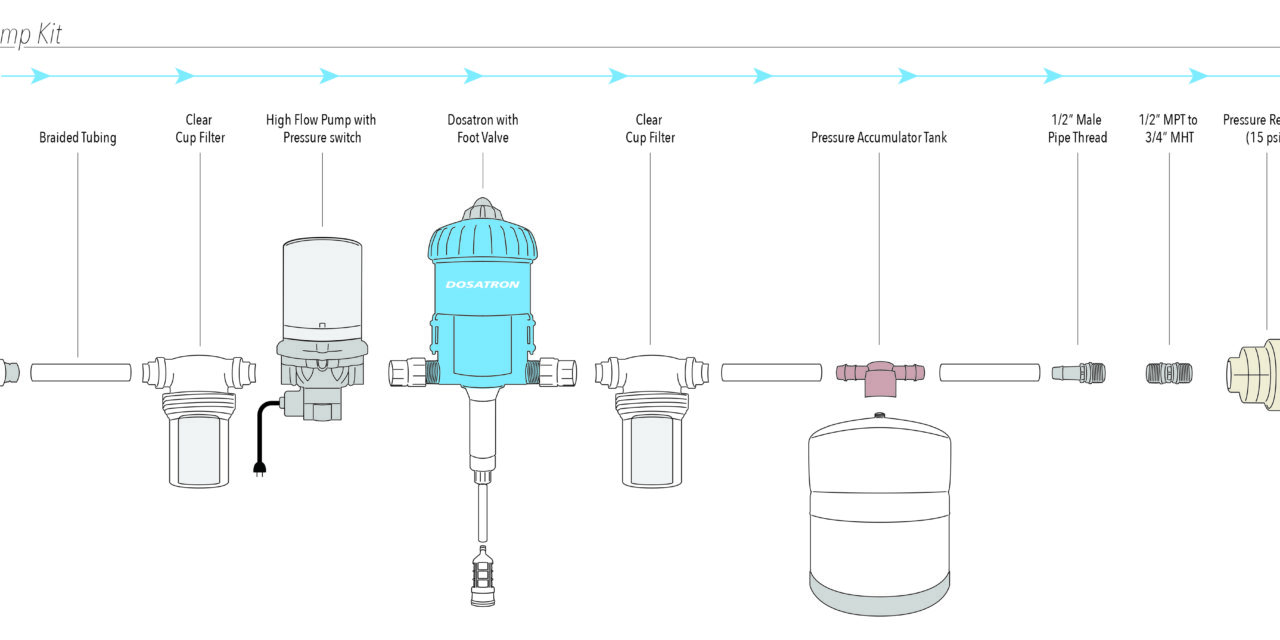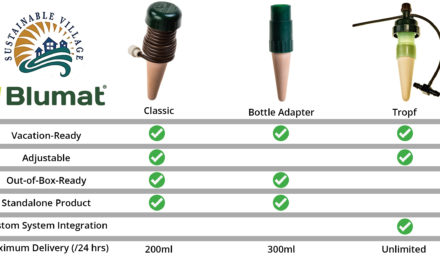Pump Kits for Blumat Watering Systems
Sometimes, pumps are preferred to source water for Blumat systems (the other two options are gravity, or a pre-existing pressurized line such as a municipal source or hose bibb).
When gravity feeds aren’t adequate, pre-existing water lines are chlorinated or otherwise unusable, or if automated nutrient-dosing is desired with a Blumat system, a pump will get the job done.
Blumat Watering Systems require a constant pressure to self-regulate, and so Sustainable Village has designed a pump/accumulator tank/pressure reducer concept that works flawlessly with their systems.
The pumps have lower-than-typical flow rates for the gardens they serve, because the flow rate on Blumat Systems is generally slow/gradual. The 3 gallon-per-minute (GPM) pump in our high-flow model can serve up to 600 Blumat sensors depending on other factors–this usually surprises cultivators, as they are used to large volumes of water being delivered in short periods of time. These irrigating techniques require more power and pumps with much higher flow rates.
The Concept
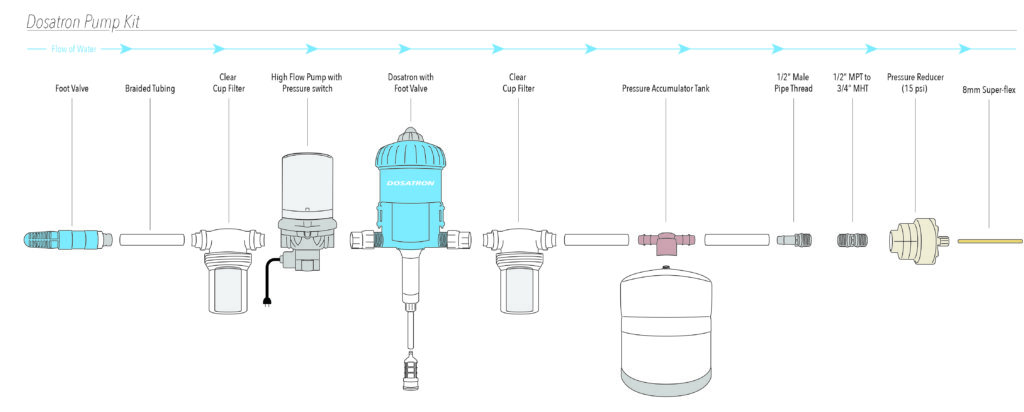
In concept, all of the Blumat Pump Kits are the same. They begin with either a bulkhead or foot valve, which the pump pulls from. It pulls water/nutrient solution from the reservoir through a filter, before going through the pump itself. The pump then goes into an accumuator tank (or, an optionally integrated dosatron configuration) before entering water supply line. Auxiliary filters can be installed following the Dosatron and throughout the Blumat system as well.
Finally, the water or nutrient solution will go through a pressure reducer before safely entering the Blumat Watering System.
How they Work with Blumat
Blumat Watering Systems require a steady and constant pressure to function properly. However, the incoming pressure must also be under 15 PSI. All of the following pump kits supply exactly that!
The pump supplies pressure and flow into the Blumat system. However, since Blumat systems deliver water on demand, there are times when the flow rate will be 0. There will also be times when the flow rate is high, and placing demands on the pump that it cannot meet. If the pump is turned on all the time, the flow could never be 0 as it is sometimes required. The pump would also burn out.
To combat this problem, an accumulator tank is used to buffer between the pump and Blumat system. The accumulator tank is pressurized by the pump, but then allows the pump to rest. The tank itself is able to supply flow and pressure to the Blumat system, but only as it is needed.
By following the accumulator tank with a pressure reducer, the pump kits in essence provide the exact same function that an open municipal line or hose bib would. It is the perfect solution for supplying a Blumat system with water and/or fertilizer mix!
Models
Basic (1.4 GPM Pump) (Mounted Version, 230V version)
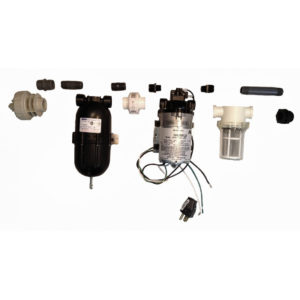
This is the basic pump kit. It is ideal for small, personal-sized grows.
Basic Pump Kit Assembly Instructions
Replacement Parts
High-Flow (3 GPM Pump)
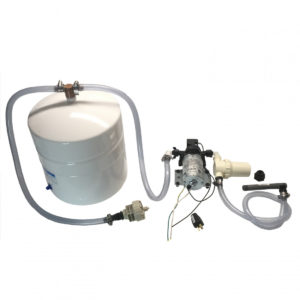
This kit is recommended for and anything larger than a personal or tent grow. It is capable of supplying several hundred feet of garden beds, or up to about 600 smaller plants on individual sensors. If using a BluSoak system, this kit should be used to supply systems with less than 5500 cumulative feet of drip tape.
High-Flow Pump Kit Assembly Instructions
Replacement Parts
- (Uses same bulkhead/filter/fittings as previous)
- Accumulator Tank
- Pump
Ultra High Flow (4.5 GPM Version, 6.6 GPM Version, 13.5 GPM Version)
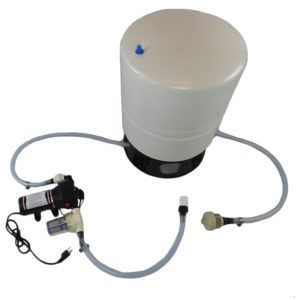
These kits are used to supply farms and larger commercial systems. The 4.5GPM model should be used for systems with less than 8250 feet of tape. The 6.6GPM model should be used in systems with less than 12,100 feet of tape. The 13.5GPM model should be used in systems with less than 24,750 feet of tape.
Replacement Parts
- (Uses same bulkhead/fittings/filter as previous)
- Accumulator Tank
- 13.5 GPM Pump
Troubleshooting
It is worth noting that almost all of the problems I hear about with the pump kits involve foot valves and/or foot valve connecting systems. Whenever possible, I urge cultivators to place their pump kit beneath the water line of the reservoir rather than being mounted above the reservoir.
- Is the filter clogged? The cup filter can be conveniently cleaned by screwing off the metal attachment and physically removing debris/bioflims/etc.
- How many wraps of tape did you apply to the pipe thread fittings? We recommend anywhere from 3-6 full wraps of tape to ensure there are absolutely no air leaks. The pump frequently pulls air through fittings with only 1-2 tape wraps, and causes severe problems.
- Is the accumulator tank charged? You can use a bike pump to charge the tanks (using the Schroeder valve) up to 10PSI. If the tank isn’t holding a charge, that’s the problem.
- When in doubt, use a pressure gauge kit to find pressure differentials in your system. These indicate the exact placement of clogs or other problems.
- Is the pump running constantly, without taking breaks? Chances are, either the accumulator tank is broken, the pressure switch on the pump is broken, or the pump is sucking air. You’ll want to reapply additional tape to threaded pipe fittings and ensure the tubing preceding the pump is completely void of air.
- Guide/Troubleshooting the Tanks
Maintenance
- Clean the filter regularly
- Use strategic “purge valves” to remove air/debris from the system periodically
- Ensure the pump does not run constantly or uptake air as this will burn the pump out
Accessories
- Foot Valve Connecting System (When the pump cannot be placed below the water line of the reservoir)
- Foot Valve
- Filter
- Accumulator Tank Fittings
- 0-30 PSi Pressure Gauge Kit (Great for troubleshooting)
- 0-100 PSi Pressure Gauge Kit (Great for troubleshooting)
- Blumat System Pressure Reducers
- 1/2″ Braided Flex Tubing
- Dual Reservoir Connection System

